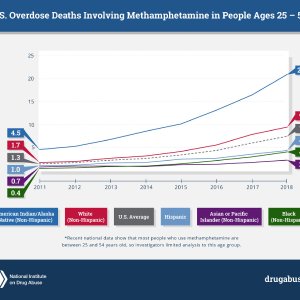What Is the Scope of Drug Abuse in Oklahoma?

Every state in the country has people living in it who suffer from drug addiction. And while addiction is widespread, it is not the same everywhere. Drug addiction in Miami, Florida, looks very different from drug addiction in rural Oklahoma.
According to recent reports, Oklahoma has a growing drug problem. It’s been getting worse for a few years now, with no sign of receding. And what is the source of this problem? Methamphetamine.
Methamphetamine is not a new drug, and its use is certainly not limited to just Oklahoma. What’s different about Oklahoma that makes this state’s predicament all the more concerning is that, in an almost unprecedented way, Oklahoma is one of the first regions in the U.S. to begin recording a stark increase in methamphetamine-related deaths.
Given that methamphetamine has not been traditionally associated with lethal outcomes among users, this is concerning.
Meth Overdose Deaths on the Rise in Oklahoma
According to research findings published in the National Library of Medicine, meth overdoses in Oklahoma surged from 2009 to 2017 while opioid deaths decreased. Meanwhile, in most other U.S. states, opioid overdose deaths skyrocketed during that same period while meth deaths stayed the same or increased slightly.
Quoting the data directly from the study authors as they commented on the overdose data for Oklahoma, “Synthetic opioids, despite a recent upward nationwide trend, showed a slight overall decrease (-6.8%) from 2009 to 2017. In contrast, methamphetamine showed a 402.2% increase from 2009 to 2017 and an overall increase of 1,526.7%.”
Not only did methamphetamine deaths increase at a rate much higher than any other drug, but meth is now the leading cause of drug-related deaths in the state. For context, 1,963 Oklahomans died from meth overdoses between 2009 to 2017, while 1,724 Oklahomans died from oxycodone. Again according to the authors, “With the intent of assessing the opioid epidemic as it relates to accidental overdoses in Oklahoma, this study suggests that opioid-related overdoses have slowed in recent years amidst a sharp increase in methamphetamine deaths.”
Oklahoma is one of the only states (if not the only state) where opioid-related deaths declined while meth-related deaths soared. It may also be the only state where more people died from meth than from oxycodone.
Why are More People Dying from Meth?

The big question here is pretty clear. Why are more people dying from meth? One of the answers lies in the demographics of meth abuse. A National Institute on Drug Abuse paper found that meth overdose deaths are much more likely to occur among American Indians. Oklahoma is the state with the second-highest number of American Indians as a representation of the total population (Indigenous peoples in Oklahoma comprise 13% of the state’s population).
According to the NIDA report, deaths involving methamphetamine more than quadrupled among American Indians from 2011 to 2018 (the same period when Oklahoma recorded a surge in meth-related deaths). The NIDA report suggested that long-term decreases in access to education, high rates of poverty, and discrimination in the delivery of health services are just some of the factors that contribute to health disparities for American Indians.
“While much attention is focused on the opioid crisis, a methamphetamine crisis has been quietly, but actively, gaining steam—particularly among American Indians and Alaska Natives, who are disproportionately affected by a number of health conditions.”
Quoting Dr. Nora Volkow, NIDA director, “While much attention is focused on the opioid crisis, a methamphetamine crisis has been quietly, but actively, gaining steam—particularly among American Indians and Alaska Natives, who are disproportionately affected by a number of health conditions. American Indian and Alaska Native populations experience structural disadvantages but have cultural strengths that can be leveraged to prevent methamphetamine use and improve health outcomes for those living with addiction.”
Another factor that has acted to spike meth-related overdose deaths has been the growing trend of drug dealers mixing opioids into meth samples to create a more potent, addictive, and lethal drug. Since 2015, the number of meth overdose deaths that also showed positive toxicity reports for opioid poisoning surged, effectively pushing meth deaths higher than normal. According to the National Institute on Drug Abuse, 1,854 people died from meth in 2010, but 16,167 people died from meth in 2019. The recent inclusion of opioids in meth batches is a part of the problem.
Another problem that has unraveled in recent years is the phenomenon of meth addicts also using opioid drugs. This is different from the above example in that these instances are not an issue of opioids being secretly mixed into a meth sample by the drug dealer. Rather, these are instances of “polysubstance abuse,” which means to use two different drugs simultaneously or to struggle with dependencies on more than one drug.
Another Clear Problem—Opioid Addiction Still a Serious Issue in Oklahoma

While meth addiction is a serious issue in Oklahoma and must be addressed, it would be doing no favors to residents if opioid addiction was ignored. Oklahoma still has the 18th highest drug overdose rate in the nation (19 deaths for every 100,000 people living there). Meth causes much of those deaths, but opioids still lead to hundreds of lives lost in Oklahoma each year.
According to the Oklahoma Health Department, from 2011 to 2015, more than 2,100 Oklahomans died from prescription opioids. More adults in the state die from opioids than from car accidents.
Oklahoma also has a serious overprescribing problem, which is part of what set off the opioid epidemic there in the first place. According to the Oklahoma Health Department, enough opioids are prescribed in Oklahoma every year for every adult to have 110 opioid painkiller pills. That is part of why, until meth overdoses started to take center stage, 60% of overdose deaths in the state involved opioids.
Treatment for Addiction—How Oklahoma Addicts and Their Families can Create a Better Tomorrow
It is crucial for those who are addicted to meth in Oklahoma to seek the help of a residential drug and alcohol addiction treatment center. Meth can be deadly, whether opiates are involved in its use or not.
It is also equally important for families, communities, cities, counties, state and local governments, policymakers, and public health experts to push for preventive efforts, such as educational programs and school interventions. Oklahomans should do everything they can to ensure that residents do not use drugs in the first place.
And last but not least, residents must find better solutions to meeting their health needs. According to the Oklahoma Policy Institute, residents have the 44th worst health ranking of the 50 states. Oklahoma ranks 42nd for poor physical health days and 45th for occupational fatalities. Improving health conditions in Oklahoma and getting residents away from drugs will take prevention and rehabilitation, and it will require a sweeping investment in public health for all who live there.
Sources:
- https://pubmed.ncbi.nlm.nih.gov/32542332/
- https://worldpopulationreview.com/state-rankings/native-american-population
- https://www.nih.gov/news-events/news-releases/methamphetamine-overdose-deaths-rise-sharply-nationwide
- https://www.ok.gov/health2/documents/Opioid_Overdose_Fact_Sheet.pdf
- https://www.drugabuse.gov/drug-topics/trends-statistics/overdose-death-rates
- https://okpolicy.org/prescription-drug-addiction-presents-challenges-oklahoma/


